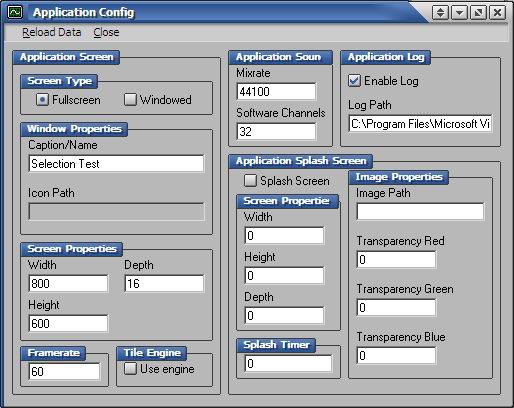
Application Screen
This section handles all properties related to the application screen or window.
Screen Type
You can either have a windowed or fullscreen application
Window Properties
If you are using a windowed application then you can set the caption that will appear in the window title bar as well as the path to the 32x32 bitmap containing the application icon
Screen Properties
Here you can set the screen properties such as the resolution (width and height) and the bit-depth (8, 16, 32)
Framerate
Here you can set the framerate not to exceed a certain amount of frames per seconds. This is important as it makes a game run at the same rate on different machines.
Tile Engine
Only select this box if you plan on using the tile engine at some point in your application, otherwise leave it unchecked. The tile engine takes over the rendering of a lot of various application objects (in order to confine them to it) and if you don't need it then it's best to let the actual object managers take care of the rendering.
Application Sound
Here you have to set the Hz at which the sound will be played back - 44100 is a common mixrate - as well as the number of software channels to be made available if there are no hardware channels or the hardware channels all become full.
Application Log
If you plan on using a log file with your application (recommended) then you should check Enable Log. Doing so will let you enter the path to the log .cfg file. If you already have a log data file loaded then the path of that data file will be automatically inserted and the extension will be changed from .dvb to .cfg
Application Splash Screen
If you want an image splash screen to pop up for a set amount of time, you must check the Splash Screen box.
Screen Properties
These properties must match the size of the image you are going to display
Splash Timer
This will set how long the splash window will be displayed. Time is set in milliseconds
Image Properties
This is where you define the path to the splash image as well as its transparency value. However since these images will always be loading against a black screen by themselves, this value really does not need to be modified ever.
Application Data
There is a special feature of application data files that needs to be mentioned. When you load and modify an application data file, it is important that you also load in any other data files that you will be using in the application. This is because when the application data file is generated, it saves the paths of the currently loaded data files so that when the application is started it can load in those objects. If you do not have a loaded data file when you generate data with an application data file loaded, those objects will not load. So if you have sprite objects but you modify the application data without loading the sprite data file, when you generate the data the application datafile will no longer contain the path to the sprite data file, and thus your sprites will not load.
| Prev: Button data |
Next:
Image data
|